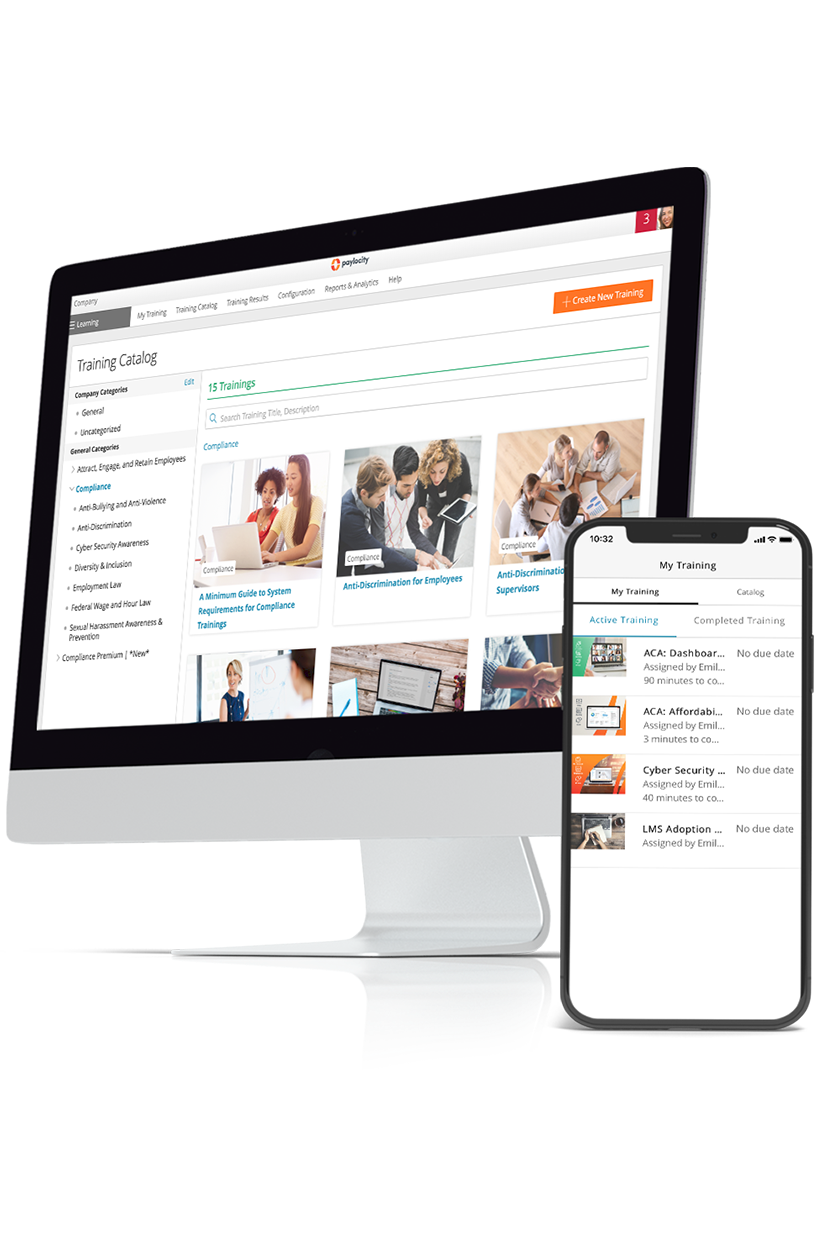?ts=1750963499181&$ProductTIleImage$&dpr=off)
Upskilling Strategies for the AI Era
"AI can free organizations to get back to the people work.” – Steve Beauchamp, Executive Chairman, Paylocity
Artificial Intelligence is no longer a futuristic dream. It’s a present-day force reshaping industries and redefining how work gets done. From streamlining operations to fueling creativity, AI is opening new doors for businesses and professionals at every level.
But to unlock AI's full potential, it's essential to develop the right skills. Curiosity, adaptability and continuous learning have never been more critical.
If you're concerned about staying competitive in an AI-driven world or ensuring your team thrives in this new environment, you're not alone. Upskilling has become a business necessity, and this guide provides actionable strategies to help individuals and organizations maintain a competitive edge.
So, how can organizations prepare their workforce to leverage AI effectively?
Key Takeaways
- AI enhances — not replaces — human work, enabling employees to focus on higher-value tasks like analysis, creativity, and interpersonal collaboration.
- Upskilling technical proficiencies and soft skills is essential, emphasizing AI literacy, critical thinking, adaptability, and ethical reasoning.
- Successful AI adoption requires a phased, people-first approach, including clear goals, continuous learning, and open communication with employees.
Why Organizations Need to Upskill for AI
AI is not just a tool for automation. It’s revolutionizing how employees learn, perform, and innovate. It's reshaping workflows, recruitment, and collaboration, while enabling organizations to achieve significant efficiency.
Consider the daily impact of this technology in the workplace:
- AI automates data analysis, saving hours of manual effort.
- Recruitment benefits from AI by facilitating skill matching and streamlining the hiring processes.
- Collaboration tools use AI to suggest scheduling, task optimization, and project roadmaps.
However, there's a clear disconnect between the skills required and the training provided. While the demand for AI expertise has skyrocketed, only 13% of workers have received any AI training.
The disparity is even more pronounced across organizational levels: In a global survey of over 12,000 employees, just 14% of frontline workers have undergone AI upskilling, compared to 44% of leaders.
Using AI to Enhance Human Roles
But... isn't AI going to take my job?
The rise of AI has understandably raised concerns among workers about job security, and in some cases, those concerns are valid — certain roles may evolve or even phase out. But the broader opportunity lies in how AI can shift the focus of work.
Rather than replacing people, it creates space for them to lean into the parts of their jobs they find most meaningful—leading to a more rewarding and purpose-driven employee experience.
In a recent webinar discussing the future of AI, Steve Beauchamp, Executive Chairman of Paylocity, notes that this shift empowers people to focus on the elements of their jobs they’re most passionate about, offering a more rewarding employee experience.
AI enhances emotional intelligence and interpersonal skills but doesn't replace them. Human-centric qualities like communication and collaboration complement AI tools seamlessly.
"One of the things that will happen over time, as organizations start to leverage AI tools, is that there will be less creation work that you'll have to do and much more analytical work," Beauchamp said. "That human layer on top of AI-enhanced tasks will become really important."
For example, AI can quickly scan resumes to identify candidates based on specific criteria, but recruiters' insights, experience, and understanding of company culture are key to finding the best long-term hires.
Similarly, while AI might flag a drop in team morale, HR leaders use intuition and empathy to drive meaningful changes, like fostering communication, adapting policies, or organizing team-building activities that align with employees and company culture.
Crucial Skills in the AI Era
We know that having the right skills is essential to leverage AI fully — but what exactly does that entail?
Technical Skills for AI
Begin by building foundational AI literacy across roles. This means demystifying the technology with practical, accessible education — what AI is, how it works, and how it’s already transforming everyday business.
Training can include entry-level workshops, team-specific learning tracks (e.g., “AI for HR” or “AI for Sales”), and internal guides that focus on real applications.
Ultimately, AI training should align with business needs and job functions to drive meaningful impact. Specific upskilling opportunities might include:
- Prompt writing for generative AI tools to draft content, summarize meetings, or automate reports.
- AI-powered analytics to uncover insights in spreadsheets or dashboards.
- Workflow automation to reduce manual tasks like data entry, approvals, or status updates— freeing up time for more strategic work
Organizations should also spotlight internal use cases, such as automating FAQs with AI chatbots, generating job descriptions with large language models, or using predictive analytics for forecasting.
Soft Skills for AI
While technical know-how is important, soft skills are just as critical for helping employees thrive in an AI-enhanced workplace.
As AI takes over more routine or analytical tasks, human strengths like critical thinking, adaptability, and creativity become even more valuable. Workers need to know not just how to use AI, but when and why.
To build these capabilities, organizations can encourage growth in areas such as:
- Critical thinking to assess AI-generated insights, flag inconsistencies, and avoid blind reliance on algorithms.
- Adaptability to embrace new tools, evolve workflows, and stay resilient amid rapid change.
- Creativity to ideate novel uses of AI or combine tools in innovative ways.
- Digital communication to explain how AI-driven outputs were reached and collaborate effectively with both humans and machines.
- Ethical reasoning to navigate gray areas in data privacy, fairness, and accountability.
By strengthening these human-centric skills, organizations empower employees to work alongside AI, not just as tool users, but as thoughtful, strategic partners in innovation.
Best Practices for AI Upskilling
Create Measurable Goals
Organizations must set clear benchmarks for AI-driven workflows.
;Measure what [AI adoption] looks like. And that drives a more collaborative conversation," Beauchamp noted. This helps ensure that AI usage is intentional and meaningful.
;Part of the challenge is you still want these tools to drive the right business outcomes," he said.
In practice, that might look like:
- Tie AI adoption goals to specific KPIs (e.g., a 5% improvement in efficiency).
- Define output expectations, such as reducing manual data entry time.
- Continuously collect and analyze feedback from teams to adjust and optimize models over time.
This method not only aligns everyone with organizational priorities but also ensures AI is contributing effectively.
Gradual AI Onboarding
Introducing AI doesn’t require a complete overhaul. Employers should take a phased approach to prevent employees, particularly those less tech-savvy, from feeling overwhelmed.
- Start with manageable tasks. Automate simple, repetitive processes first (e.g., AI-assisted scheduling or email writing).
- Use specific use cases to demonstrate AI’s value. Small impacts, like cutting meeting prep time, illustrate tangible benefits.
- Foster understanding with team training. Highlight how AI works alongside employees rather than replacing them.
Showing success through incremental wins creates more willingness among teams to adopt AI-driven solutions.

Leverage Employee Feedback
To successfully integrate AI at work, start by understanding your team’s concerns. Effectively addressing employee fears about AI is critical for gaining trust and collaboration.
Here are practical approaches:
- Conduct employee surveys or focus groups to assess concerns and expectations about AI adoption.
- Communicate openly through team meetings or Q&A sessions, creating opportunities for dialogue.
- Use existing communication channels to provide transparent project updates, framing AI tools as enhancements rather than threats.
By encouraging feedback, organizations can tailor strategies to match real-world employee expectations, paving the way for smooth AI integration.
Continuous Learning
AI evolves with new functionality each year. For individuals and organizations to thrive, adaptability must be embedded in the company’s DNA.
Beauchamp emphasizes the importance of creating consistency for AI training.
Go back to your formal training program that you already have, and insert AI as a topic to build the knowledge uniformly across your existing employees, and also embedding it as you have turnover and role changes," he recommends.
In practice, this looks like:
- Regularly update training programs to reflect current AI capabilities.
- Provide access to online certifications, workshops, and resources, covering topics like machine learning or AI ethics. Leverage a learning management system to make learning on demand.
- Use mentorship and cross-functional collaborations to encourage organic skill-sharing across teams.
For example, offering programs where experienced data analysts exchange insights with new hires ensures knowledge transfer while promoting collaboration. Be sure to record and document this expertise for easier dissemination throughout your organization.
Embrace AI with Paylocity
As AI continues to reshape the world of work, the most successful organizations will be those that invest in their people just as much as their technology. Upskilling isn't just a response to change; it's a catalyst for innovation, resilience, and long-term growth.
Beauchamp underscored that this is a boon for employees and HR professionals alike.
"AI can free HR organizations to get back to the people work that they really had the passion for in the first place and eliminate the necessity of all of the task work that needs to be done from HR teams," he said.
Harnessing the power of AI requires the right technology for implementation and a commitment to upskilling your workforce. Paylocity's HCM has AI embedded throughout the platform, transforming the way you work and communicate. It empowers you to be more effective, proactive, and creative with less.
Enjoy benefits such as:
- AI Assist to transform raw ideas into professional, succinct announcements in the communication platform, Community.
- A learning management system to automate AI training assignments and keep proof of completion with auto-logged training documents in the employee record
- AI-powered insights reduce unplanned overtime costs, ensure appropriate role-based shift coverage, and minimize no-show rates.
Want to learn more? Request a demo!

Grow Your Talent with Better Training
Now, more than ever, employees want more career development opportunities from their employers. The right Learning Management System (LMS) can help develop new skills while training your workforce on company policies, products, and more. Empower your employees to grow professionally with Learning, a modern, mobile solution that fits different learning styles and connects to your existing systems and processes.




